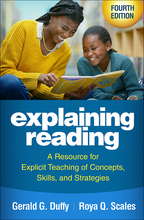Explaining Reading
Fourth Edition
A Resource for Explicit Teaching of Concepts, Skills, and Strategies
Gerald G. Duffy and Roya Q. Scales
Foreword by Seth A. Parsons
New to This Edition
- Many of the 30 examples are new or revised, and give increased attention to reading–writing integration.
- Chapter on classroom experiences that promote reading for meaning.
- Chapter on organizing and managing differentiated instruction, including for English learners.
- New discussions of student motivation and agency.
“Duffy and Scales have created a vital resource for teachers who want to teach reading concepts explicitly while aligning their instructional practices to support comprehension. The book guides teachers in the kind of thinking that expert teachers do, using concrete classroom examples. The fourth edition has a heightened focus on student agency and motivation. This book is essential reading for preservice, beginning, and veteran teachers, as well as for professional development providers who want to promote adaptive, visionary, and effective reading teachers.”
—Margaret Vaughn, PhD, College of Education, Washington State University
“This book takes the 'secret' out of reading by showing how to teach comprehension skills and strategies through clear, step-by-step lessons. The 30 sample lessons model what teachers can say and do to guide students toward true understanding. Each lesson includes adaptations for different grade levels and subjects, making it practical and flexible. As an EL teacher, I value the focus on differentiation and supporting English learners.”
—Monica Kula, MA, Bilingual Teacher, Pennoyer School District #79, Norridge, Illinois
“As a teacher of paraprofessionals earning education degrees, I often hear my students express that despite extensive experience in schools, they lack the confidence to try some of the teaching techniques we discuss in class. The fourth edition of Explaining Reading not only provides excellent content, but does so in a way that empowers educators to create authentic and explicit lessons that will foster students' motivation in their classrooms.”
—Joy Myers, PhD, Executive Director, Grow Your Own Initiatives, James Madison University
Table of Contents
Foreword, Seth A. ParsonsPreface
I. Introduction
1. Focusing on Meaning
2. How Comprehension and Word Identification Work
3. How to Use Part II of This Book
4. Tips for Managing Differentiated Instruction
5. A Final Word: Teachers Make the Difference
II. The Teaching Examples
Examples for Comprehension Generally
- Example 1. Word Meaning
- Example 2. Using Context Clues to Determine Word Meaning
- Example 3. Predicting
- Example 4. Predicting, Monitoring, and Repredicting
- Example 5. Inferring
Examples for Explaining Literature Strategies
- Example 6. Reading for Key Details
- Example 7. Theme
- Example 8. Character Traits and Motivations
- Example 9. Descriptive Words and Phrases
- Example 10. Story Structure
- Example 11. Point of View
- Example 12. Compare–Contrast
- Example 13. Illustrations and Text Meaning
Examples for Explaining Informational Text Strategies
- Example 14. Main Idea
- Example 15. Text Features
- Example 16. Text Structure
- Example 17. Analyzing Positions and Views
- Example 18. Evaluating
- Example 19. Summarizing
- Example 20. Drawing Conclusions
- Example 21. Synthesizing
Examples for Explaining Word Identification Skills
- Example 22. Print Detail
- Example 23. Sight-Word Recognition
- Example 24. Phonological Awareness: Discriminating among Sounds
- Example 25. Letter–Sound Association
- Example 26. Vowel Patterns
- Example 27. Syllabication
- Example 28. Structural Analysis
Examples for Explaining Fluency
- Example 29. Reading with Expression
- Example 30. Quick Recognition of Easily Confused Words
Appendix: Research Foundations Supporting This Book
Index
About the Authors
Gerald G. Duffy, EdD, is the former William E. Moran Distinguished Professor of Literacy and Reading at the University of North Carolina at Greensboro and Professor Emeritus at Michigan State University. Now retired and living in Bellingham, Washington, he was an elementary and middle school teacher, researcher, and teacher educator for over 50 years. His teaching and research focused on the explicit teaching of reading, on comprehension, and on the development of adaptive teachers. A past president of the Literacy Research Association and a member of the Reading Hall of Fame, Dr. Duffy has worked with teachers and children across the United States and internationally. He has written and edited several books on reading instruction and has published over 150 articles and research studies.Roya Q. Scales, PhD, is Professor of Literacy Education at Western Carolina University. An educator for more than 30 years (11 as a K–2 classroom teacher), she is noted for her research on thoughtfully adaptive teaching, enactment of teachers’ visions, literacy teacher education, and effective teaching of literacy. She is currently Editor of Reading & Writing Quarterly: Overcoming Learning Difficulties. Dr. Scales is the recipient of the 2022 Association of Literacy Educators and Researchers A. B. Herr Award for outstanding contributions to literacy education. With 50 peer-reviewed publications, she has coauthored several books on reading instruction and teachers’ professional development.
Audience
Classroom teachers and literacy specialists working with children ages 5–13 (grades K–8); staff developers; teacher educators and students.Course Use
Will serve as a supplemental text in advanced undergraduate- and graduate-level courses.Previous editions published by Guilford:
Third Edition, © 2014
ISBN: 9781462515561
Second Edition, © 2009
ISBN: 9781606230756
First Edition, © 2003
ISBN: 9781572308770
New to this edition:
- Many of the 30 examples are new or revised, and give increased attention to reading–writing integration.
- Chapter on classroom experiences that promote reading for meaning
- Chapter on organizing and managing differentiated instruction, including for English learners.
- New discussions of student motivation and agency.
